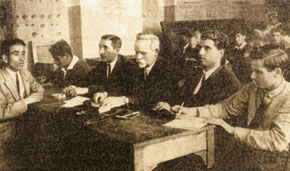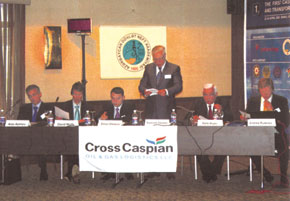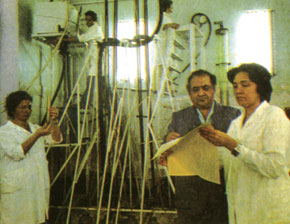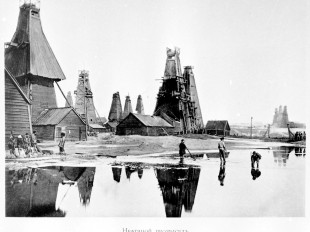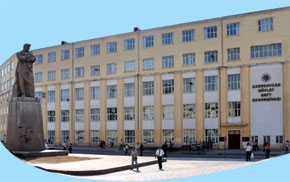 Pages 62-65
Pages 62-65By Mais Amrahov
Stages in its history
Once the Bolsheviks had occupied Azerbaijan (April 1920) many industries, including oil and gas, were nationalised and one of the first problems faced was the absence of professionals; there was an immediate demand for engineers with a higher education. Within a month this issue was being discussed at a meeting of a special commission, on 20 May 1920, leading to the People’s Commissariat for Education passing an inquiry to the Revolutionary Committee of Azerbaijan. On 12 December 1920, a special commission under the chairmanship of Leonid Ishkov was set up by People’s Commissar for Education Dadash Bunyadzadeh, and a project was prepared to organise the institution. Bunyadzadeh signed a decree, “The Establishment of a Polytechnic Institute in Baku” on 14 November 1920 and the Chairman of the Revolutionary Committee, Nariman Narimanov endorsed it on 20 November. A commission under the chairmanship of Professor Kozlov was charged with concluding admissions by 1 January 1921. Kozlov was appointed the first rector until 1 September 1921. By decision of the Institute on 15 December 1920, Samadagha Vakilov was appointed Secretary of the Scientific Council, and deans of faculties were appointed on 18 December. Studies began at the Polytechnic Institute on 2 January 1921. 1923 saw the first three graduates emerge from its doors.
The Baku Polytechnic Institute gave diplomas in engineering to 13 people for the academic year 1923-24, to 46 people in 1925-26 and to 289 people in 1926-27. In 1929, the Institute was transferred from the People’s Commissariat for Education to the Head Office of Higher Technical Schools. I.G.Yesman was the Institute’s rector from 1922-1928, M.V.Barinov in 1928, and A.A.Nikishin from 1929-1932.
N.Dubrovski was appointed Dean of the Economics faculty and N.Lebedev Dean of the Agriculture faculty at the Scientific Council of the Baku Polytechnic Institute on 18 December, 1920. Later, as a result of agricultural reform, the Agriculture faculty was removed from the Polytechnic Institute, becoming a separate institute under the People’s Land Commissariat on 12 May 1929. The Economics faculty was closed the same year.
Following these changes and in view of the Institute’s specialisation in oil and gas, related faculties were retained and, on 29 May 1930, the name was changed to the Azerbaijan Oil Institute (AOI). The Institute then was taken under the wing of Ittifaqneft (Oil Union) and the Azerbaijan Correspondence Institute was created as a section of the main Institute. Later, branches of the Azerbaijan Correspondence Institute were set up in Ganja, Grozny, Ufa, and Ishimbay, affiliated to the Azerbaijan Oil Institute. As part of the process of specialization in the Institute, the Water Management faculty was transferred to the newly established Transcaucasia Cotton Institute. The Azerbaijan Construction Institute was created out of the Institute’s Construction faculty, but was then returned to the Oil Institute as the Faculty of Architecture and Construction.
Ten years, targets and wartime service
AOI celebrated its tenth anniversary on 1 January 1931. Alongside the decision to celebrate the jubilee, the Institute was set a target of preparing 1,000 – 2,500 specialists during the next five-year period.
As the Institute grew in size, the number of Azerbaijani students increased. While there were only ten among those who graduated between 1920 and 1930, that number rose to 121 for 1931-32 and 160 for 1932-1936.
From 1932-33 A.M.Gegodayev and in 1933-1934 S.R.Kiselyov were rectors of the Institute and From 1934 to 1938 the Institute was managed by one of its own graduates, I.S.Akhundzadeh.
In 1934 the Institute was renamed the Azerbaijan Industrial Institute and several faculties changed their specializations. The same year, the Institute was transferred to the People’s Commissariat for Heavy Industry and, new faculties emerged, the Institute began preparing professionals in new specializations and there were many other changes.
Before the war, from 1939-1941, the Institute was managed by Musa Mirza oglu Aliyev and in 1941 S.B.Gojayev was appointed rector.
With the outbreak of war in 1941, the Institute’s goals were changed accordingly. Professors and students were sent to the army, so there were problems in both training new skilled professionals and in conducting scientific research. Despite these difficulties, education continued. The Institute accepted 1,147 entrants in 1943 and 810 entrants in 1944. In 1945 there were 4,500 students in education at the Institute. 1,000 engineers were educated during the war years. The Institute staff collaborated in collecting funds for the front, supplying the front with fuel and lubricating materials, sending food and clothing to the soldiers etc. The Institute’s professors frequently visited military hospitals, met injured soldiers and conducted lectures for them. They presented 200 books and various gifts to a total value of 581 roubles to soldiers in hospitals No 3682 and No 4956. They participated in assistance to regions freed from fascist occupation. More than 100 of the Institute’s staff were awarded medals ‘For Protection of the Caucasus’.
Recovery
The war ended in victory for the Soviet army. All resources were then directed towards the recovery of the national economy. Of course, educational centres could not be left out of this effort. AOI worked for the recovery of industrial areas, especially of the oil industry, as did all other graduate schools. They prepared professionals to develop newly discovered oilfields in the regions of Ural-Volga, Emba, Central Asia, Kazakhstan and the Far East. In 1946 the institute was transferred from the USSR People’s Oil Commissariat to that of the Head Office of Polytechnic and Industrial Higher Education Institutions. Changes were made to the structure of the Institute in 1950. In 1952, the Azerbaijan Polytechnic Institute was created, based on the faculties of Architecture and Construction, Transportation and part of the Mechanics faculty, together with the Hydro Improvement faculty of the Azerbaijan Agricultural Institute, to prepare specialists in the fields of civil construction, transportation and machine-building. With the emergence of this new Institution, 57 professors and 11 departments were transferred there from the AOI, which, therefore, continued to prepare specialists solely for the oil industry. Evening and correspondence classes were increased. As part of reforms to the education system, the Institute’s name was changed again to the Azerbaijan Oil and Chemistry Institute (AzOCI), on 14 March 1959.
In all, the Institute prepared 6,695 engineers between 1951 and 1959. 3,501 of them were Azerbaijanis and 749 were female. In these years, several faculties were transferred from other institutions to AzOCI, while the specialization of radio-technician was transferred from AzOCI to the Polytechnic Institute. In the academic year 1958-1959, a department for evening classes and correspondence education was opened in Sumgayit. On 30 March 1960, an educational advisory office for education by correspondence and evening classes in AzOCI was also opened in Sumgayit. That same educational advisory office was converted to a branch of AzOCI during the academic year 1962-1963. The first entrants were accepted to the branch in 1962; 225 attended evening classes and 125 applied for education by correspondence. The problem of supplying oil and chemical enterprises in Sumgayit with specialists was being solved. 726 people received education at the Branch in the academic year 1968-69. The previous year had ended with 235 graduated specialists.
The Sumgayit branch of AzOCI became the independent Azerbaijan Industrial Institution 30 years later, in 1992, and Sumgayit State University on 13 May 2000.
AzOCI celebrated its 45th anniversary in 1965. In 45 years, more than 20,000 specialists, including 5,000 Azerbaijani specialists (1,420 of them female), graduated from it. In its anniversary year, AzOCI had 13,000 students, more than 700 lecturers, 30 professors and 200 associate professors. There were nearly 400 scientists and engineering-technical staff in 13 problem areas in 5 fields, scientific research laboratories. Among the students were more than 400 foreign students from 31 countries.
The Institute was directed by Professor I.A.Ibrahimov in 1960, and by Professor K.N.Guluzadeh in 1970.
The Azerbaijan Oil and Chemistry Institute enhanced its activities in the years between 1960 and 1970. The Institute prepared specialists for 31 specializations. AzOCI had research laboratories tackling 14 scientific questions in 8 fields, 72 departments, 58 professors and scientists, 445 candidates of science and 1,034 scientific and engineering specialists. The post-graduate section prepared specialists in 33 areas.
On the 60th anniversary of AzOCI, celebrated on 26 September 1981, the Institute reported on its 60-years’ work. The rector, academician I.A.Ibrahimov, described the Institute’s successes, saying that the benefits of the scientific research conducted by its scientists during the previous decade had amounted to over 60 million roubles, that 422 copyrights had been registered, more than 500 basic textbooks and other educational materials prepared, more than 1,000 young people had been through faculty preparation, and nearly 1,100 foreign citizens had returned to their countries as highly qualified specialists.
First steps after independence: successes and problems
Academician Tofig Aliyev was the rector of the Azerbaijan Oil and Chemistry Institute during the years 1989-1992. In 1992 the status of the Institute was changed and it was renamed Azerbaijan State Oil Academy (ASOA), by decision #137 of the Cabinet of Ministers. Professor Parviz Mammadov worked as rector of ASOA from 1993 to 1997. From the academic year 1993-1994, ASOA began a specialist course to bachelor level.
7,168 entrants were accepted from 1991-1995, 6,652 from 1996-2000; there were 7,220 and 6,484 graduates, respectively.
In June 1997, Professor Sayavush Garayev was appointed the rector. Between the years 1991-1995, 209 enterprise contracts were delivered, to a total value of 96.85 million AZN. During these years, students were prepared in 37 specialisations, 289 received postgraduate degrees, 17 monographs and 92 textbooks and other educational materials, and 88 methodological textbooks were prepared, 1,863 scientific articles were written and 223 patents were obtained by the Academy’s professors and lecturers.
In 1998, with support from the US Information Agency, and based on cooperation between Georgia State University and ASOA, a master’s education in business administration was launched. The contents of educational materials and curriculums were adapted to Western standards for this project and leading managers from various international companies were invited into the educational process. Graduates from this programme have already achieved a fine reputation in oil production. They hold leading positions in companies like BP, Azer-Chirag-Gunashli, SOCAR, Bakcell, Ata Holding, Azercell and Statoil.
In 1999, a master’s programme in Environment and the Oil Industry was launched. The programme follows an educational curriculum adapted to European standards, with support from SOCAR and Ecole du Pétrole et des Moteurs in Paris, based on cooperation between the Sophia Antipolis University in Nice, France, and Genoa University in Italy, as part of the European Union’s TEMPUS Programme.
ASOA’s success and its relations with technical schools in other countries have enhanced its reputation even further. On 13 June 2000, the President of the Azerbaijan Republic signed a decree, giving ASOA the right to self-administration.
One of the most important events in ASOA’s life was the celebration of its 80th anniversary. In 80 years more than 70,000 highly qualified engineers have been prepared for Azerbaijan and 70 other countries by the institution. The first extraction of oil from the seabed was conducted in the Caspain Sea in 1949 and should be evidence of the high qualifications attained by Azerbaijani geologists and oilmen. ASOA’s international relations have expanded with membership of the European University Association and the organization INCORVUZ with UNESCO status, and with participation in the ITAS Programme.
The Academy has functioned more productively during the last decade and has effected changes in the quality of its graduates. The main developments, however, have been in international relations.
In 2002, ASOA implemented new projects to prepare specialists. A computer lab was opened in April 2002 with the help of ITOCNU OIL Exploration Co. Ltd. A locally networked Information Technology laboratory was opened in 2003 with the help of AMEC. In 2004, bachelor programmes on specializations in Automation and Information technology and Electroenergetics were opened in ASOA within the framework of the EU’s TEMPUS Programme, in cooperation with the University of Applied Sciences in Köln, Germany and the Heerlen School of Applied Sciences in Holland, based on a curriculum adapted to European standards.
In general, there was an increase in ASOA’s scientific potential and significant developments in quality took place during the years 2001-2010. In the academic year 2009-10, ASOA had 86 PhDs, 390 candidates of science and 362 lecturers.
International relations
The Academy’s International relations have been targeted in three directions: the establishment of graduate technical schools in foreign countries with the help of professors and lecturers, lecturing in foreign graduate schools and experience exchange.
During the Soviet period, Azerbaijani education centres conducted international contacts via Moscow. However, the situation as regards international relations changed significantly after independence. A higher quality of international relations was established in education, as in other fields. As a result, in the period from 1990 to 2000, 30 of ASOA’s employees worked in schools in Turkey, Algeria, Cyprus and Iran. There was further progress after the signing of the Contract of the Century. Scientific and educational relations with Exxon Mobil, Schlumberger, Chevron, BP-Amoco, the Turkish Petroleum Corporation etc. were developed. ASOA is a member of the European University Association and of the organization INCORVUZ (International Coordination Council of Educational Institutions Alumni) since 1998.
The decade from 2001 to 2010 may be seen as bringing a revolution in ASOA’s international relations. The main aspects of international relations in those years consisted of preparing high-quality specialists for foreign economies, mutual contacts with schools in foreign countries, participation in international education programmes, cooperation with international companies, student exchanges, membership of international organizations and, finally, internship opportunities for local professors and lecturers in foreign schools.
One of the main aspects of ASOA’s international relations is the work carried out with foreign students. The Institute prepared 200 engineers and 14 candidates of science for European, Asian, and African countries in the years 1963-1969. Among ASOA graduates is Angola’s incumbent president, Jose Eduardo dos Santos.
As time went by, the number of international students in the Institute increased. In 1970 340 young people from the German Democratic Republic, the Republic of South Vietnam, Guinea, Afghanistan, Syria, the Democratic Republic of Vietnam, Iraq, Sierra Leone, Jordan, Algeria and the UAE attended the Institute for faculty preparation. 170 students from Europe, Asia and Latin America were attending classes in their own specialisations. 136 were graduate students and the other 34 were postgraduate students. In all, 13,000 foreign students from 99 countries attended the Institute for faculty preparation from its establishment in 1961 until 2010. In 2010, 119 foreign students from 10 countries were studying at the Institute.
The Academy stays in touch with its foreign students and watches their progress carefully. ASOA graduates currently work in schools and scientific centres in their home countries. Postgraduate student from Egypt, Mohamed Al Zarka, and Indians Palajkhala Benkata Krishna, Bkhusarki Arvind and Satkariya Madon went on to be organizers of scientific research work in their home countries. Afghani geologists Amir Gol Mirzad, Gurbanali Mansur, Abdukhaliq Vatanyar Khaydari and others have also achieved great success. As already mentioned, Institute graduate Jose Eduardo dos Santos is the elected President of Angola; Zelk Frank was deputy director of the Central Geology Institute of the German Democratic Republic; Nguyen Zao, Head of Department of the Geology Institute in Hanoi, Vietnam; Benyahya Abdallah, Dean of the National Oil, Gas and Chemistry Institute in Bumerdes, Algeria; and Ismayil Ahmad Musa, Head of Department in the Ministry of Geology of the Yemen Republic.
The Academy’s library is very important to the preparation of these qualified specialists. While there were only 6,500 books in 1920 and 300 readers, the library has grown and been enriched over the years. On 1 January 2010, there were 866,000 volumes and the process of digitalizing the library has begun.
ASOA was the first technical school for oil and gas. It is now 91 years old. On 23 February 2010, the President Ilham Aliyev signed an order on the celebration of the Academy’s 90th anniversary. In a speech about the Academy, the president said:
…the Azerbaijan State Oil Academy has become a high quality education centre in oil, gas, and the oil-chemistry industry, preparing highly qualified professionals for both our republic and abroad since the time since its creation .
Terror act in ASOA
This event was a truly shocking and bloody page in ASOA’s history. On 30 April 2009, an armed terrorist entered one of ASOA’s buildings and began firing at students. 13 people died and 12 were injured. This terrorist act produced feelings of deep sorrow, not only among the students, but across the whole of Azerbaijan. However, everyone pulled together and overcome this tragedy. The action was met by appropriate response from the government.
Today, ASOA continues its mission as one of the world’s reputable centres of education, and continues to prepare highly qualified specialists for the oil and gas industry in Azerbaijan, as well for the world.
About the author: Mais Israil oglu Amrahov is a Doctor of Historical Science and professor. He is the author of research into the history of Azerbaijan and the history of education in the country.
